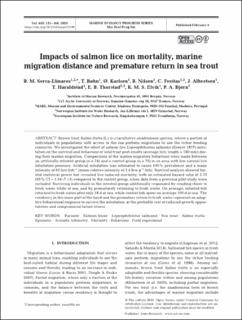| dc.contributor.author | Serra Llinares, Rosa Maria | |
| dc.contributor.author | Bøhn, Thomas | |
| dc.contributor.author | Karlsen, Ørjan | |
| dc.contributor.author | Nilsen, Rune | |
| dc.contributor.author | Freitas, Carla | |
| dc.contributor.author | Albretsen, Jon | |
| dc.contributor.author | Haraldstad, Tormod | |
| dc.contributor.author | Thorstad, Eva Bonsak | |
| dc.contributor.author | Elvik, Kristine Marit Schrøder | |
| dc.contributor.author | Bjørn, Pål Arne | |
| dc.date.accessioned | 2020-07-03T10:14:41Z | |
| dc.date.available | 2020-07-03T10:14:41Z | |
| dc.date.created | 2020-02-20T10:42:53Z | |
| dc.date.issued | 2020 | |
| dc.identifier.citation | Marine Ecology Progress Series. 2020, 635, 151-168. | en_US |
| dc.identifier.issn | 0171-8630 | |
| dc.identifier.uri | https://hdl.handle.net/11250/2660681 | |
| dc.description.abstract | Brown trout Salmo trutta (L.) is a facultative anadromous species, where a portion of individuals in populations with access to the sea perform migrations to use the richer feeding resources. We investigated the effect of salmon lice Lepeophtheirus salmonis (Krøyer 1837) infestation on the survival and behaviour of wild trout post-smolts (average fork length = 180 mm) during their marine migration. Comparisons of the marine migratory behaviour were made between an artificially infested group (n = 74) and a control group (n = 71) in an area with low natural lice infestation pressure. Artificial infestation was estimated to cause 100% prevalence and a mean intensity of 65 lice fish−1 (mean relative intensity of 2.4 lice g−1 fish). Survival analysis showed limited statistical power but revealed lice-induced mortality, with an estimated hazard ratio of 2.73 (95% CI = 1.04−7.13) compared to the control group, when data from a previous pilot study were included. Surviving individuals in the infested group additionally responded by residing closer to fresh water while at sea, and by prematurely returning to fresh water. On average, infested fish returned to fresh water after only 18 d at sea, while control fish spent on average 100 d at sea. The residency in the inner part of the fjord and the premature return to fresh water represent an adaptive behavioural response to survive the infestation, at the probable cost of reduced growth opportunities and compromised future Fitness. Parasite · Salmon louse · Lepeophtheirus salmonis · Sea trout · Salmo trutta · Epizootic · Acoustic telemetry · Mortality · Behaviour · Field experiment | en_US |
| dc.language.iso | eng | en_US |
| dc.publisher | Inter Research | en_US |
| dc.rights | Navngivelse 4.0 Internasjonal | * |
| dc.rights.uri | http://creativecommons.org/licenses/by/4.0/deed.no | * |
| dc.title | Impacts of salmon lice on mortality, marine migration distance and premature return in sea trout | en_US |
| dc.type | Peer reviewed | en_US |
| dc.type | Journal article | en_US |
| dc.description.version | publishedVersion | en_US |
| dc.rights.holder | © The authors 2020 | en_US |
| dc.subject.nsi | VDP::Marinbiologi: 497 | en_US |
| dc.subject.nsi | VDP::Marine biology: 497 | en_US |
| dc.source.pagenumber | 151-168 | en_US |
| dc.source.volume | 635 | en_US |
| dc.source.journal | Marine Ecology Progress Series | en_US |
| dc.identifier.doi | 10.3354/meps13199 | |
| dc.identifier.cristin | 1796019 | |
| dc.relation.project | Havforskningsinstituttet: 14650 | en_US |
| cristin.ispublished | true | |
| cristin.fulltext | original | |
| cristin.qualitycode | 2 | |

